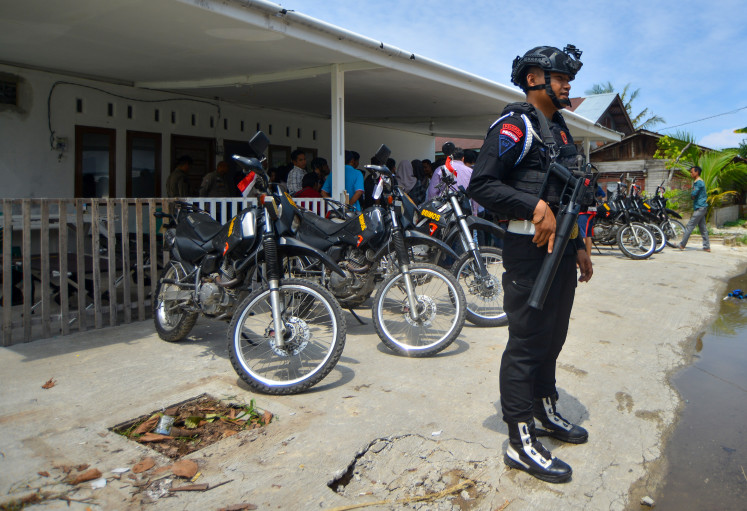Popular Reads
Top Results
Can't find what you're looking for?
View all search resultsPopular Reads
Top Results
Can't find what you're looking for?
View all search resultsDevelopment of Patimban Port as a well-planned project
The main objectives of its development are to improve the national logistics index and collaborate with Tanjung Priok Port to serve as a new and competitive hub in Southeast Asia.
Change text size
Gift Premium Articles
to Anyone
I
nfrastructure development is often seen as a quick win to promote both short-term and long-term economic growth in a region. The short-term impact related to the construction activities will create multiplier effects on other sectors and regions. However, infrastructure development should not be conducted solely for improving the economic activities without integrated regional development and proper planning. The absence of regional development and proper planning will potentially leave the infrastructure underutilized, resulting in project failure, cash flow problems and even losses.
There are several examples of underutilized infrastructure projects in Indonesia. However, there are also many good examples of well-planned infrastructure projects that should be used as an example in building other infrastructure. One of which is the Patimban Port project.
Patimban Port is one of the national strategic projects (PSN), located in Subang, West Java. The main objectives of its development are to improve the national logistics index and collaborate with Tanjung Priok Port to serve as a new and competitive hub in Southeast Asia. It is in a strategic location where interconnectivity has been in development, including toll access, railways and near industrial estates. Additionally, the development of Patimban Port is also marked as the first step toward a new metropolitan area called Rebana, which includes Sumedang, Majalengka, Cirebon, Subang, Indramayu and Kuningan regencies and Cirebon municipality. The metropolitan area itself was home to 9.3 million people in 2019.
The construction of Patimban Port started in 2018 and it is expected to be in full operation in 2027. As of today, Patimban Port is in phases 1-2 until 2023 and has been operating since 2021. Currently, Patimban Port has the capacity of 160,000 completely built-up (CBU) cars and 250,000 twenty-foot equivalent units (TEUs) of cargo. The government is using a public-private partnership (PPP) scheme and will continue its development until the port reaches the capacity of 600,000 CBU car terminals and 5.5 million TEUs of cargo with the total investment estimated at around Rp 43.2 trillion.
In the short term, we believe this project will be beneficial for West Java and the national economy. Using a traditional 17-sector Inter-Regional Input-Output (IRIO) analysis, we estimate the construction of this project will have an economic impact of Rp 33.6 trillion value-added, equivalent to 2.22 percent of the West Java gross domestic regional product (GRDP) in 2021 or a total of Rp 39.8 trillion (0.36 percent of Indonesia’s GDP in 2021), accounting for its spillover effect to other regions. Additionally, we estimate this project will also increase the total income by around Rp 10.8 trillion for West Java and Rp 12.8 trillion of national income. Furthermore, this port development is expected to create 361,000 jobs in West Java and 46,000 jobs elsewhere, creating 408,000 jobs in total.
In the long-term, Patimban Port will provide greater benefits to Indonesia’s economy as it provides several advantages. First, Patimban Port will reduce the burden of the existing major port, Tanjung Priok, allowing for more goods to be traded in and out of Indonesia. Coordinating Minister of Maritime and Investment Affairs Minister Luhut Pandjaitan said in 2020 that Patimban Port will reduce the current traffic at Tanjung Priok, which accommodates around 52 percent of international trade traffic in Indonesia.
Second, Patimban Port will also reduce logistics costs, particularly for industrial estates located around West Java. It is estimated that the average time to move goods from industrial estates in West Java to Tanjung Priok is around four to five hours. In comparison, it will only take one to two hours to move goods to Patimban Port. Thus, the efficiency gained from this port will include a shorter time to move goods, lower fuel consumption and less maintenance for trucks. As Patimban will reduce the volume of goods traded from Tanjung Priok, the port may also reduce the overall traffic to Jakarta (particularly on the Jakarta-Cikampek toll road), reducing the average time to export goods from Tanjung Priok.
Last but not least, this port will have a capacity of 600,000 CBUs. Since the opening of the car terminal in Patimban Port in December 2021 (with a 160,000 CBU capacity), this port has accounted for around 33,000 tons of passenger car exports under HS code 8703 in the first quarter of 2022. In comparison, Tanjung Priok Port has accounted for 89,400 tons. It means that Patimban Port accounted for around 27 percent of HS 8703 while previously Tanjung Priok accounted for 99.7 percent of HS 8703 exports in Indonesia.
Patimban Port will play an important role in the automotive sector performance in the future. The domestic car market had reached its peak in 2013 – 2014, with total sales of 1.2 million units sold. On the other hand, exports (CBUs) reached their peak at 332,000 units right before the pandemic in 2019. The share of car exports for both domestic and international markets keeps increasing from 10.8 percent in 2011 to 25 percent in 2021. This figure shows that Indonesia’s automotive sector is ready to expand its foreign markets. Thus, the role of Patimban Port in increasing Indonesia’s logistic competitiveness will also be beneficial for the future performance of the automotive sector.
All in all, we believe that the Patimban Port project is an example of a well-planned infrastructure project. Several aspects need to be imitated for future infrastructure projects. First, the location of the project should be well-planned in a way that it is integrated with regional development and have proper interconnectivity with other infrastructure. As the Patimban Port's main objective is to reduce the burden of Tanjung Priok, therefore the location of this port is not too far from the Tanjung Priok Port as well as near the main user of the port, industrial estates. Second, the participation of local government is also crucial for an infrastructure project. This will allow the regional development plan to be drafted with the infrastructure in mind. Therefore, the development of the infrastructure will come from both central and regional governments.
--
Industry and Regional Analyst at Bank Mandiri










